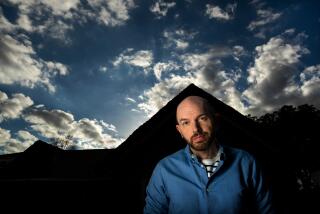One last cry of rage
Amonth ago, I found myself at the hospital bedside of my friend Willie Middlebrook, as he lay paralyzed on his right side. It was a week before his latest solo show was due to open at Avenue 50 Studio, the community art gallery in Highland Park, and a few weeks before his work âWanderersâ would be unveiled at the Expo Lineâs new Crenshaw station.
Willie, a great photographer, master technician and storyteller, had been working in his Inglewood studio the day before, printing the final piece for the Avenue 50 show. He laid it out on a table and suffered a stroke. And now, floating into consciousness from a medicinal fog, Willie wanted to talk about the show.
He told me the exact dimensions of each work, exactly where he wanted it placed, precisely how it was to be hung. The stroke had silenced half his body, but clearly his whole brain was motoring along at full speed.
Then he transitioned into the genesis of the new work: Trayvon Martin.
âI really had no idea what I was going to do when I agreed to do the show,â he confessed, âand then they shot that poor boy in Florida.â
There was a meme going around the Internet, of folks posting webcam photos of themselves in hoodies, like the one Trayvon wore the night he was killed. Willie wrapped a maroon blanket around his head (âI didnât have a hoodie big enough to fit meâ) and took a picture. He studied his visage on his monitor, fiddled with it a bit in Photoshop, and then the artist inside him took over.
He brought a smiling school photo of Trayvon into the composition, started adding textures and arranging things, creating another of his deeply soulful works -- complexly layered digital images, visual tone poems and novellas of the African American experience, and of real life in L.A. -- only this time with bitterness mixed in.
From his bed, Willie recounted how Trayvonâs killing had triggered a flood of memories -- at once historical and personal -- of race-related hatred and violence: Emmett Till, tortured and tossed into the Tallahatchie River; Laura Nelson and her son Lawrence, lynched off an Oklahoma bridge; Martin Luther King Jr. and Medgar Evers, assassinated; the four girls killed in a Birmingham church bombing; and most recently, young Kendrec McDade, shot and killed by police in Pasadena.
Willie choked up as he spoke and wailed, just wailed -- long, mournful moans that caused us to worry he might bring on another stroke.
He connected this violence to the everyday racism he had encountered in his life, racism that extended even to his enviable role as a well-known artist. Invited to attend a showing of his work in the South a few years back, he was met at the airport by a representative of the arts center, who was visibly shocked to discover that the artist was a large black man with dreadlocks, and who then canceled his speaking engagements and interviews, explained there would be no reception, handed him his honorarium and told him to enjoy the rest of his stay at the hotel, no hard feelings.
It was painful to hear, and clearly, as tears streamed down Willieâs face, it was painful to recall. And when his show, provocatively titled âI Own Nigger,â was installed at Avenue 50, it was painful to see how all of these incidents and connections had coalesced into seven large-scale photo-paintings of sadness and rage.
One doesnât need to know how these images pushed a great artist to a physical breaking point to be moved by them. But the back-story does illuminate the costs of creating a record of resilience in the face of so much violence and intolerance.
Willie certainly had resilience and determination; he was a lion of a man. In the hospital, every conversation he had with friends was about returning to his art. And every conversation with hospital staff, and later with the rehab staff, was about how to make that possible.
We all thought Willie was going to make it. But on May 4, Willie passed. He never made it back to the studio; he never saw his last show.
It is tempting to look at the seven works in the Avenue 50 show and imagine that all the pent-up anger and sorrow they reflect is what killed Willie Middlebrook; that on some level he too was a victim, a martyr to racial hatred. But the art is too strong. These images are not the statement of the oppressed; they are the statement of someone who refused to be oppressed.
Even the showâs in-your-face title is defiant. As Willie told me that day in the hospital, âIâm saying, âYouâve called me nigger all my life, so Iâm taking ownership of it. Itâs mine! And if youâre going to use that word without my permission, then youâre going to have to pay me for the right.â â
Willie wrote an artist statement sometime back that holds true for all his art over these 30-plus years:
âAfter spending almost all of my ... life seeing negative, non-quality or no images at all, of my people, I decided that there was a need to direct my focus exclusively to producing great images of my people; not necessarily in a positive light, but always in a true light.... I seek to communicate to all, to all willing to listen. Thank you for listening.â
We heard you, Willie. Well done.
More to Read
The biggest entertainment stories
Get our big stories about Hollywood, film, television, music, arts, culture and more right in your inbox as soon as they publish.
You may occasionally receive promotional content from the Los Angeles Times.










